Are you still using sales funnels to map your marketing to customer journeys? There’s a better way to do it: It’s far more accurate and it aligns with lead nurturing and trust-building in content marketing.
It’s called lifecycle marketing, and it’s trending big. This new framework is all about giving your audience what they need and want as they move through their buying journeys. They run the show; meanwhile, you’re there at every touchpoint, providing value.
But, before we can get into why and how lifecycle marketing works with the modern buyer’s journey, we need to explain why sales funnels don’t work anymore.
1. Understand why sales funnels are inaccurate
Everyone in the industry, it seems, is talking about audience trust—that building it is a pillar of successful content. In fact, in the most recent Budgets, Trends, and Benchmarks Report from MarketingProfs and Content Marketing Institute, that was one of the top takeaways: 90% of all respondents said they put their audience’s informational needs above promotional/sales messages.
That’s a very good thing. It’s what modern buyers want—as opposed to the aggressive sales funnel mentality.
What’s so inaccurate about sales funnels when we apply them to modern buyers? A few things:
- The structure of a funnel, as you’ll have noticed, is wide at one end and narrow at the other. The wide part symbolizes a giant net that scoops as many prospects as possible into your funnel—whether they’re qualified to buy or not.
- The narrow end of the sales funnel symbolizes pressure on the buyer to pull the trigger with a purchase. William Townsend, the creator of the original sales funnel model (circa 1924), describes it as “the forcing by compression [emphasis mine] of a broad and general concept of facts through a funnel which produces the specific and favorable consideration of one fact.”
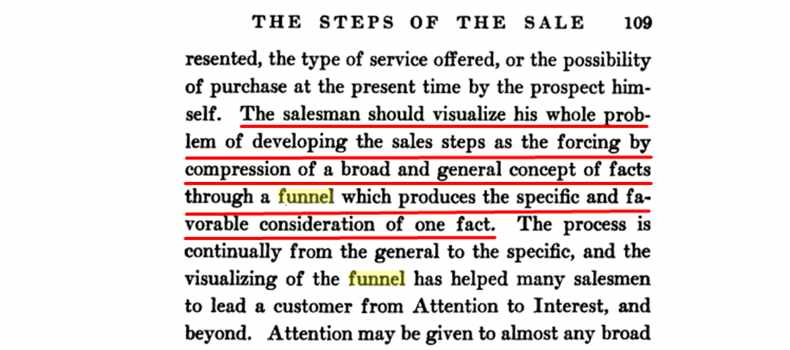
- Modern buyers’ journeys are not even close to so linear, not to mention they hate impersonal marketing and cold/aggressive sales tactics.
How do we know that?
- According to a study from SnapApp and Heinz Marketing, 60% of Millennials are “sales avoiders” who wait until the middle or the end of their buying process to talk to sales.
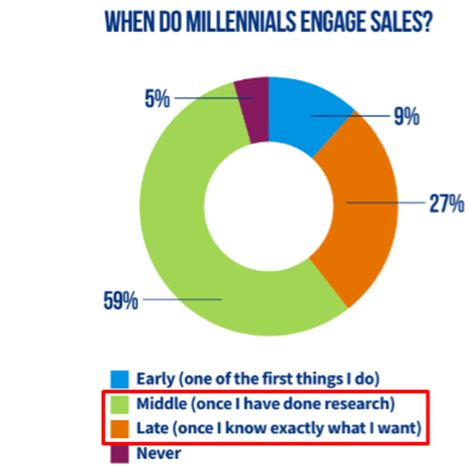
- The same study found that cold calls/emails are the most hated parts of marketing/sales across all generations of B2B buyers.
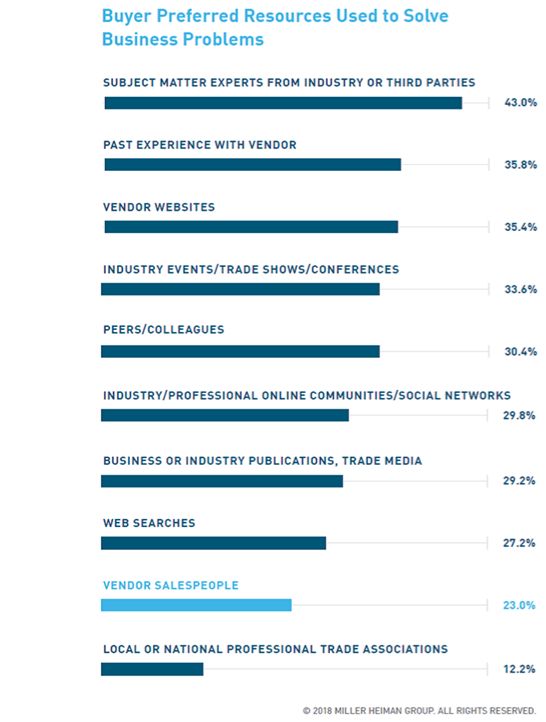
- Finally, we can’t talk about modern buyers without mentioning ad blockers. eMarketer’s latest report shows that 25% of American Internet users block ads. And a 2017 AdBlock Plus and Global Web Index report said users ad-block mainly because the ads they see are either “irrelevant” or “annoying.”
When people are outright avoiding salespeople, ads, and sales in general, we know something is up.
What are buyers doing instead?
They’re researching, information-hunting, comparing and contrasting. They’re taking their buying journeys into their own hands and directing what happens. Fully 67% of the buyer’s journey is now conducted digitally, according to SiriusDecisions.
The modern buyer’s journey is not straightforward; rather, thanks in large part to the Web, it’s unpredictable, independent, and self-directed.
2. Learn how lifecycle marketing works and how it connects to the buyer’s journey
Sales funnels don’t accurately model the modern buyer’s journey. Lifecycle marketing does.
Here are the differences.
A. The lifecycle marketing model has no closed walls

The lifecycle model breaks down the walls of the sales funnel and opens up the buyer’s journey model. In other words, it maps to real-life, modern customer journeys.
Instead of a single path with only one direction, lifecycle marketing looks at the buyer’s journey as a series of many open pathways. No matter where the buyer starts his or her journey, the directions they can go in are limitless. The lifecycle marketing model matches the unpredictability and freedom of today’s buyers.
This chart from Smart Insights is a good visualization of how lifecycle marketing matches up with just one type of modern customer journey:
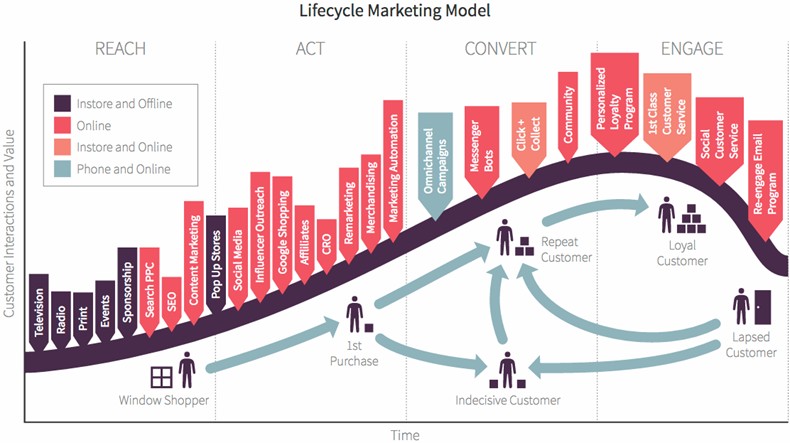
What’s most important is that at every stage the buyer is in charge. The brand doesn’t push, force, or coerce; instead, you’re simply there at every touchpoint to provide guidance, information, support, or some kind of value.
B. It includes loyalty as a major stage
Another big difference between sales funnels and lifecycle marketing: Sales funnels don’t account for brand loyalty. Lifecycles do. In fact, loyalty and customer retention are two of the main goals of lifecycle marketing.
Granted, there are some updated sales funnel models out there that squeeze in a “retention” stage at the very end of the funnel. However, the model is still off, because it doesn’t accurately map how customers will remain in your marketing loop. The funnel cliff edge is still there.
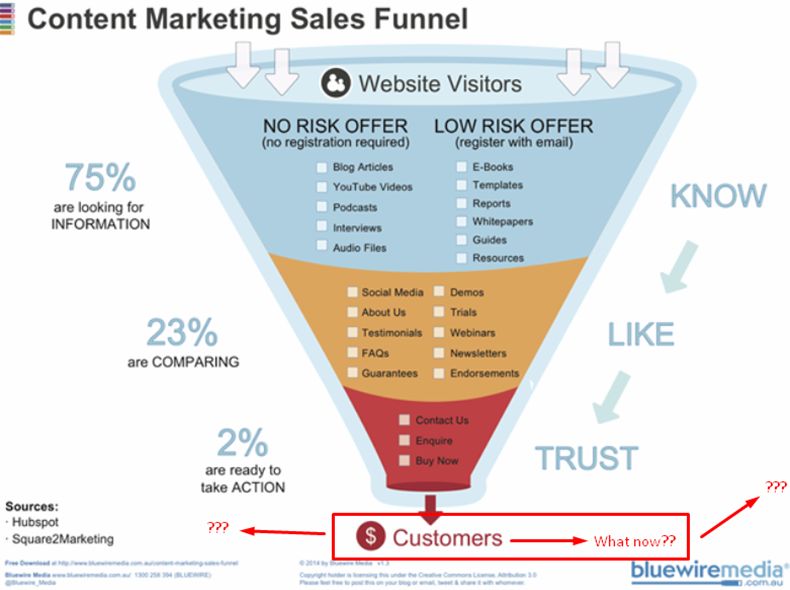
Source: Bluewire Media
C. The shape is circular
As you might have guessed, the shape of the lifecycle model is important to understanding how it works.
It’s circular—a potential infinite loop. Once prospects become customers, they aren’t spit out and forgotten at the end of your sales process.
Instead, they’re warmly welcomed into the fold. You keep pulling them in with stellar, high-value content marketing, email marketing, customer support, conversations, and social media. You keep responding to their needs, delighting them, and providing value, which builds brand loyalty and occasions multiple sales.
According to Neil Patel, customer satisfaction increases customer lifetime value (the total value a customer provides in revenue throughout their time with your brand). The more satisfied they are, the longer they’ll stay within your lifecycle marketing ecosystem. The longer they stay, the more their worth grows.
A funnel shape does not represent such a cycle. A circle does.
3. Map your audience’s search intent to lifecycle stages
Now that you understand why lifecycle marketing makes more sense for modern customers, how do you map your buyers to that model?
It’s pretty simple: Determine their search intent to connect them to the appropriate lifecycle stage; then, you can strategically reach them with the right content and contact to build loyalty.
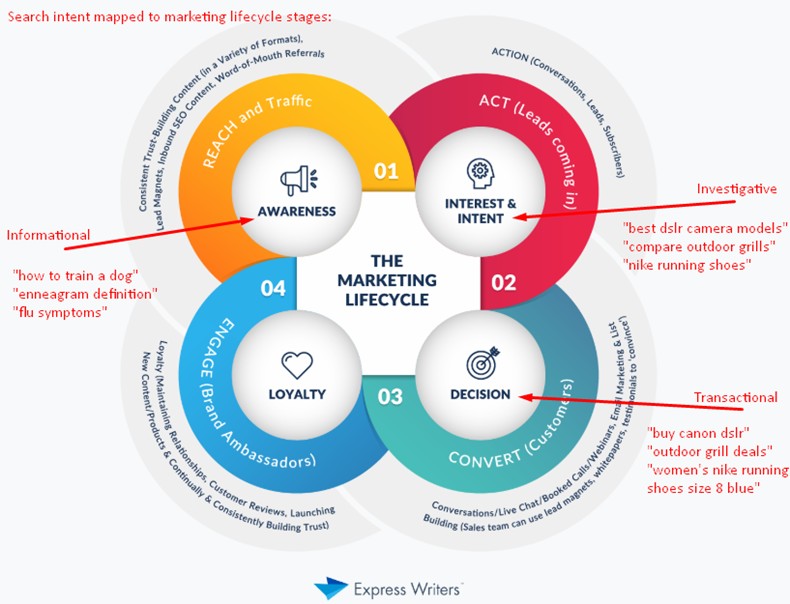
Here is how that plays out:
- Informational search intent maps to Awareness: The buyer is problem-aware and searching for information/solutions.
- Investigative search intent maps to Interest & Intent: The buyer understands their problem/information needs and is looking for the best option/solution out of a few.
- Transactional search intent maps to Decision: The buyer knows exactly what they want and are ready to commit.
Far more than sales funnels, lifecycle marketing accurately reflects the modern buyer’s journey. If you use it in your content strategy, you’ll be able to meet your customers where they need you, no matter the stage.
What’s more important: Lifecycle marketing is all about nurturing relationships and building brand loyalty, which is what content marketing strives to do, too. Match those two up in your strategy, and you’ll be able to give buyers exactly what they need and want.